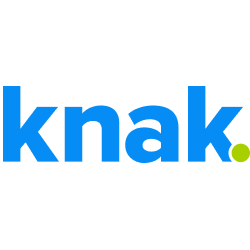Marketing is changing—and fast. Email is still the dominant marketing channel, but a lot is happening in the digital world. In 2022, how do you stack up against your competition?
Knak surveyed over 200 marketing professionals and compiled the findings in our 2022 Email Marketing Benchmark Report.
Here are six major findings from the study.
1. Email is more prevalent than ever
Email is still a prevalent marketing channel, and its use has increased year over year. For example, 71% of survey respondents say they sent more emails in 2021 than the year before. And it's paying off: Clickthrough rates are increasing, too; they're now at 10%, on average (up 4.4% from last year).
Because there are more personalization options for email than ever (thanks to marketing automation platforms and better marketing technology), you can get your message across in a way that resonates with your audiences, no matter who they are.
So if you're still not taking your email strategy seriously, it's time to start thinking about it.
2. Building emails is still a challenge for many
Even if you're already on board with an email strategy that supports your campaigns, setting up the emails can feel overwhelming, especially because there is increasing pressure to execute campaigns faster and at higher volumes.
And it's not just about sending the email; there are countless options for building them. It may also be confusing to figure out what kind of content you should include in each part of the email journey—and that's not even getting into how emails should be designed, who should see them, and why they matter.
So, how exactly are teams doing it?
Only 12% of marketing teams say they are still hand-coding their emails, and even fewer say they are working with agencies to build their assets. Templates reign as the most popular choice for marketers at 56%, but templates can still fall short when adding responsive elements, implementing specific requests, and conducting A/B testing.
Codeless email creation platforms (like Knak) are becoming increasingly popular to lower costs, increase execution time, and allow for greater creativity and flexibility. Those benefits result in email performance rates that are 28% higher than average for marketers using email creation platforms.
3. Marketing teams are becoming even more decentralized
More teams are responsible for marketing efforts now than ever before.
In the past, marketers have held a lot of power, exerting control over content creation. That's because marketing teams have historically been centralized and the marketing team itself owned most of the content produced.
However, in 2022, that dynamic is shifting rapidly. As companies scale and departments and products grow, marketing teams are increasingly spreading into verticals, enabling more marketers to create their own emails. Many also adopt a hybrid model.
Although it's more prevalent in larger companies, 43% of teams now have five or more people building emails for their company. A similar percentage (35%) have five or more people creating landing pages.
The driving factors behind the move to decentralization are faster execution and implementation of designs—although it may be slightly more difficult to maintain brand standards. However, collaboration and brand consistency can be streamlined with the right tools.
4. Marketers are democratizing creativity
As teams branch off and become more decentralized, they no longer have to rely on a single team member or agency partner to build out emails and landing pages. In turn, they get to be more creative and collaborative.
So, who exactly is designing emails now? Our survey found that most emails are being built by marketing and in-house design teams. For landing pages, it's mostly the marketing team with support from the Web team building them.
Although it's great that marketers have more opportunities to be creative, there are still obstacles, such as limited design resources, lack of in-house skills, and difficulty with coding that stand in the way. As a way to help mitigate those issues, teams are turning to collaboration and creation platforms.
5. The speed to market keeps accelerating
A common and important metric for many campaigns is speed to market. Processes need to be more efficient in the race to stay relevant and deliver exciting content.
Some top barriers that slow execution time are approvals, editing, collaboration, and email-building. However, most of the marketers we surveyed say they can get their emails and landing pages to market in minutes or hours.
A streamlined approvals process without too much back-and-forth and a smaller reliance on agencies help. Plus, almost 80% of teams using email creation platforms say they feel that their email creation process is somewhat or highly efficient, so there's something to be said about using the right tools, too.
6. Landing pages are on the rise
Because they complement emails, landing pages are a great way to increase conversion rates. They're focused on a single conversion goal, so your messaging and design can be laser-focused. They're also good for testing messaging and design for new products or services.
Although not every campaign needs a landing page, building one creates an excellent opportunity for improving campaign performance. For example, half of our respondents say they created more landing pages in 2021 than the year before, and those pages averaged a 14% conversion rate.
The top three ways marketers build landing pages are by using a landing page creation platform, using HTML, and using their marketing automation platform's builder.
* * *
So, what does all that mean for the future of email marketing? We can expect to see more emails being sent out faster. And they will be more customized and interactive than ever before.
Email and landing page creation platforms are more important than ever to execute your campaigns to reach such new levels of efficiency and creativity.
Check out our 2022 Email Marketing Benchmark Report for even more stats and findings on where email is and where it's going.




